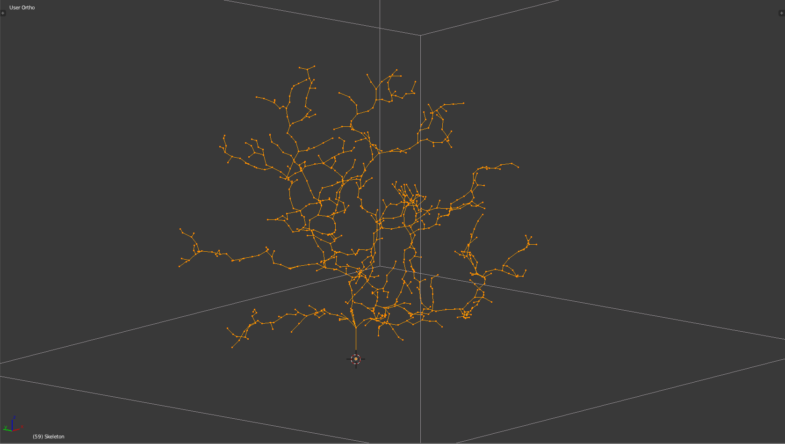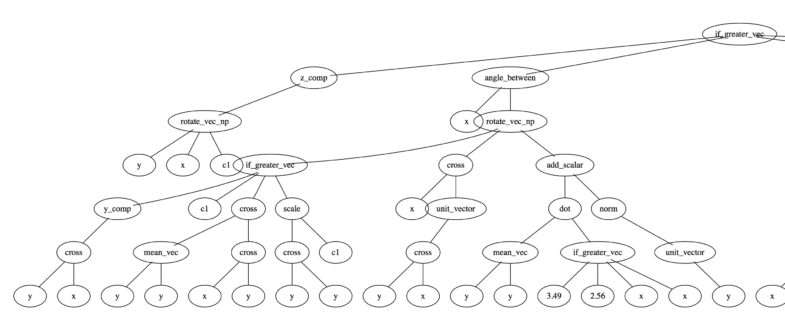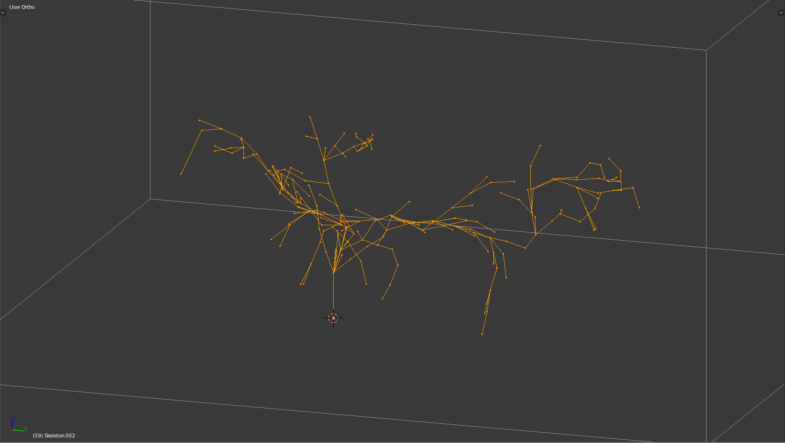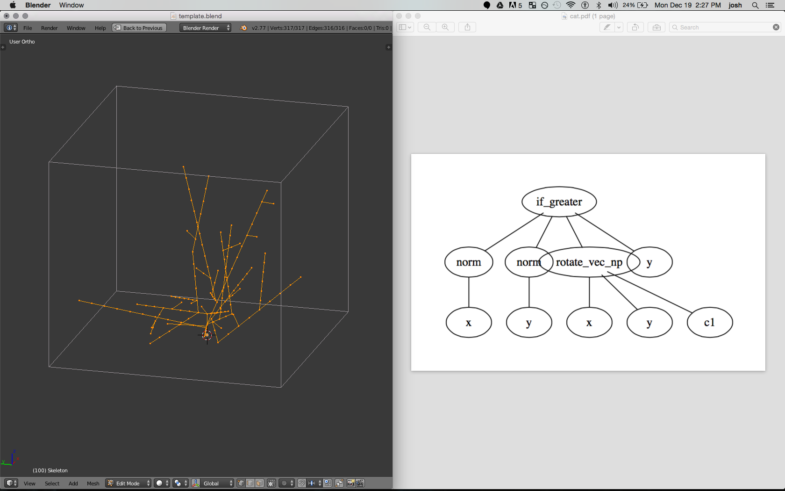Here are some more plant-shapes that are 'grown' in the same simulation environment, but with different randomly generated growth rules. Note the variety in shapes! See the previous post for a detailed explanation. I am posting the most interesting structures I have come across, but many of the randomly generated rules result in 'boring' shapes, like a vertical line. Beware my aesthetic bias!
Since the last post I realized why many of the structures grew preferentially in a certain direction. This was because of the primitive functions 'add,' 'multiply,' and 'subtract' that operated element-wise on two vectors. Such element-wise operations are likely two take two vectors and make all there elements more positive, or more negative, or some combination. Because this affects the y-vector of the next node, this has a positive-feedback effect, resulting in structures that grew in one direction. I removed those functions for now.
gnarly-spindly-tree Below is a structure tagged gnarly-spindly-tree (I am using git tags to keep track of interesting structures along the way.) Kinda reminds me of a blue-oak (Quercus douglasii)
This node-edge shape could be thought of as the 'phenotype' in the context of the evolutionary algorithm.

Below is the full processor tree for the above structure. This can be thought of as the 'genotype.'

Here is a close up of the processor tree 'genotype.'

I have added some more primitive functions since the last post, like cross product for vectors, extracting the x, y, z component, and finding the angle between vectors.
Here are some more fun shapes!
shagy-wild-bush. For this one the processor tree is so huge its not very informative to look at.

straight-segment-bush I like how simple this processor tree is, but still leads to an interesting growth shape. I probably would not have come up with this myself. Since the processor tree is simple enough to evaluate yourself, I'll explain its parts: x and y are vectors (see prev. post for description of what they are). Norm( vec ) outputs the length of the input vector. Rotate_vec_np( vec1, vec2, angle ) rotates the first vector about the second vector, by some angle in radians (c1=.5 in this case). If_greater( arg1, arg2, arg3, arg4 ) outputs arg3 if arg1 is greater than arg 2, otherwise it returns arg4. Thats it!

No-Name Alas, the below structure was generated before I created a system for saving and 'resurrecting' processor trees.

A note on how I save the processor trees: I mentioned above that I am using a git tag to save out interesting shapes. In the past when working on generative projects like this coral one, I tried to save out lists of parameters with a given shape. The problem with this is that as soon as I changed the code and added new parameters or completely different behavior, those parameter lists were useless! This time around I realized that that the entire code base of the project at the time the form is generated is the 'DNA' of a given shape. So really the best way to save that information is using git, a version control system for keeping track of code. I started the practice of committing all relevant code after an interesting shape was found, and then immediately using ' git tag some-descriptive-name ' to associate that tag with a certain shape. That worked well until I started messing around with the randomly generated programs I have been referring to as 'processor trees.' To save these I have the script save a .txt file which contains a text representation of the processor tree. For example straight-segment-bush uses this processor tree:
if_greater(norm(x), norm(y), rotate_vec_np(x, y, c1), y)
If the structure is one I want to save, I copy the file and rename it, and I create a git tag of the same name. That way if I change the primitive set of functions that the processor tree uses, I can still go back to the version of the code where the primitive set was correctly configured for that processor tree. In this case I use
git checkout refs/tags/tag-name
To re-enstate the code. Finally, there is a function in the deap.gp library that can recreate the working processor tree from the text-based representation. That's how I can resurrect an extinct virtual organism!